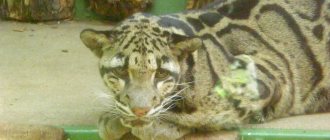Who is the dune cat? This majestic and independent animal is the smallest member of the cat family. In Russia it is almost impossible to meet these animals, although today some exotic lovers are already beginning to appear who import and breed them. Another name for this species is sand or desert cat, which determines its natural habitat. Despite such an insignificant prevalence in our latitudes, the sand cat remains a most interesting representative.
Dune cat: interesting facts
These are not domestic purrs at all, but wild predators accustomed to surviving in harsh natural conditions. They were opened quite a long time ago. Back in 1858, North African representatives of desert cats were discovered. This was not the last discovery. Already in 1926, the sand cat was rediscovered, this time in other parts of the world. In particular, it was the Kara-Kum and Kyzyl-Kum desert. Today, this is one of the few miniature representatives of the cat family that live in the wild. Under natural conditions, they live in Southern Morocco, Tajikistan and Uzbekistan, in Kazakhstan and the central part of the Arabian Peninsula.
Surprisingly, these small and weak-looking animals can go without water for weeks, which means they can survive in the most difficult climatic conditions. The secret is simple: during the day, cats hide in holes to avoid excess fluid loss, and at night they hunt and get the necessary moisture along with food. Such features ensured the possibility of survival in the desert.
History of the discovery of the sand cat species
The sand cat is a small predatory animal from the wild cat family. It is also called the Arabian or sand cat. This species became known in 1858. French General Marguerite conducted an expedition in North Africa. While passing through the Algerian desert, he discovered a wild animal that looked like a cat. The expedition included a naturalist scientist, he explained that the species had not been described before. The dune cat was named Felis margarita (in honor of the general who first saw him).
sand cats have been known since the 19th century
Some people call desert cats velvet cats. But this is incorrect, since the Russian name for the cat is associated with dunes, and not with velvet. But there is no such species as the velvet cat.
When scientists began to describe the beast, it was already fully adapted to life in hot desert conditions. No one could explain how the cat appeared in Africa (and how it adapted to these conditions). A little later, representatives of the species were found in Eurasia (Central Asia). People liked wild animals so much that they wrote songs and fairy tales about them.
About four thousand years ago, a tribe lived in the desert. The son of the tribal leader drew everything he saw on the stones. One day the settlement was attacked, but the boy's teacher managed to turn his student into a dune cat (this animal has sharp claws, but no traces). The boy had to get to a neighboring tribe and convey a request for help to the leader's brother. When help arrived at the boy’s settlement, it was already too late. The brother of the deceased leader saw the rock paintings and understood everything. He wanted to return the cat to its human form, but it disappeared somewhere. The child decided to remain a desert cat until he finds his parents. They say that the boy is still looking for his parents, but in vain. Only sometimes can you see a lonely dune cat in the desert, looking sadly at the drawing.
What does a sand cat look like?
This is a fairly small representative of the cat family. You can even call it small. A distinctive feature is the “shod” soles of the paws. The sand cat lives among hot sand, and a thick layer of thick and hard fur protects its sensitive pads from burns. In addition, such soles create a high supporting surface, which is necessary for animals to move deftly among quicksand and sandy surfaces. The fur of these cats is quite short, but very thick. This coat provides excellent protection from temperature changes: from cold at night, and from intense heat during the day.
Exterior
Body length is only 70-90 cm. This is together with the tail, which makes up at least 40%. That is, the cat’s body itself is only about 40 cm. The height at the withers barely reaches 24 centimeters, and the weight is 3.5 kilograms. If you consider that there are domestic cats weighing 15-20 kg, then these are absolutely crumbs. The sand cat, or sand cat, is perfectly adapted to survive in natural conditions. Its color allows it to completely blend with the surface of the dunes. Colors range from golden to light brown. There are also light gray individuals, but this is rather an exception.
Description of the breed
Dune cats fascinate with their coquetry and curious expression in their eyes. Thoroughbred representatives have the following appearance:
The head of the breed is large and wide, slightly flattened in front.
The ears are what primarily distinguishes this breed from all others. The ears are very wide, and their position is very low, atypical for cats. This structure of the ears is explained by the fact that dune cats use them as locators when hunting prey. In addition, the ears are slightly bent in front. Considering that the animals' natural habitat is sandy terrain with dunes, slightly bending their ears forward protects them from sand.
The eyes are small and slanted. The eye color is yellowish, although you can find representatives of this breed with emerald green eyes.
The paws are short, but their lack of length is compensated by well-developed and powerful muscles, thanks to which the animal can develop high speed and has good physical endurance.
The coat is short but very thick. The thickness of the coat saves the animal from freezing on cold nights in the desert, and during the day, when it is hot, the coat helps retain the required amount of moisture
Thick hair is present between the pads of the toes, and this is very important, as it protects the cat’s paws from burns on the hot sand. Dune cat fur is hypoallergenic
Contact with it will not cause a negative reaction even in those people who are prone to allergies to cat hair.
The color is sandy, which plays a camouflage role, making the animal completely invisible among the sand dunes. The back of the Arabian cat is mottled with dark stripes along the spine, which gradually darken and become completely black at the base of the tail. There are thin contrasting lines on the cat's paws and head. The sternum is lighter than the main color.
Based on the appearance and nuances of coat coloring, the dune cat breed is divided into several subspecies:
- Margarita is a sand color, but brighter and more saturated; there are several black rings on the tail, their number varies from 2 to 6 pieces.
- Thinobia - representatives of this subspecies are distinguished by the largest body sizes. The color of their coat is very dull; the pattern of stripes characteristic of the main breed is present, but it is weakly expressed, almost merging with the main color. There are black rings on the tail, their number is from 2 to 3 pieces.
- Scheffeli - dull coat color is compensated by pronounced stripes and several black rings on the tail.
- Harrisoni - a distinctive feature of cats of this subspecies is the presence of a dark spot on the fur behind the ear. The number of rings on the tail changes with age; an adult animal has 7 of them.
The body length of an adult reaches about 90 cm; at the withers, the height of a dune cat is up to 30 cm. The weight of a mature male is about 3.5 kg.
Enemies
Jackals are desert dwellers and pose a huge threat to Arabian sand cats. Animals are afraid of wolves and large carnivorous birds. The main enemy of the dune cat, which is responsible for the mass extermination of the breed and the reduction in the number of individuals, is man.
The unusual, beautiful appearance of the animal and its exoticism are the reason for mass hunting of this breed of cats. Poachers hunt for sand cats only for the purpose of their further sale to zoos, private menageries and for domestic keeping. The animal's fur is of no interest to poachers.
It is unknown how many predators are left in the wild at the moment, which is explained by their secretive lifestyle. At the moment, the dune cat breed is protected by a world organization.
Natural habitat
The sand cat is a true extreme animal with an amazing ability to survive. These animals live even in the driest areas, surviving among the dunes, where the landscape is brightened only by dry bushes. Having adapted to such difficult conditions, cats lead a nomadic lifestyle. They constantly move through the desert in search of food. It is very difficult to detect this cat; it moves so easily that it leaves no traces. The activity of these animals is observed mainly at night, since during the day it is too hot, and the prey hides in holes. Often attempts to find representatives of this species ended in failure. The cat hides very well, moves, clinging to the ground, and when it notices the trace of a flashlight, it presses itself even closer to the sand and closes its eyes so that the light does not reflect in them.
Diet
Like all other members of the family, these cats are predators. Under natural conditions, they eat everything they can catch. These can be jerboas or hares, snakes and large insects. These little ones manage to catch quite large prey, and the cat will never throw away the remains of the meal, but will bury it to return the next day. A sand cat at home retains its instincts, so you are guaranteed eggs under the pillow and bones behind the cushion of the sofa.
To save precious moisture and protect themselves from the heat, cats dig minks for themselves, but this is only a last resort. Most often they use the old shelters of foxes and other desert inhabitants.
Animal health
Although the Serval is healthy, vaccination is recommended for him in the same way as for other domestic cats. A veterinarian will not give a cat a vaccine that contains active viruses, as this can cause illness and death.
The cat will not say what is bothering it, so you need to focus on its atypical behavior and movements around the house. If there is any doubt, go to see a doctor.
Diarrhea requires the most attention. This is a direct road to dehydration, and in a short time. If your Serval cat has diarrhea, intravenous treatment may be required. If you have loose stools twice, you need to go to the vet. They look for the cause of the disease and prescribe adequate treatment.
The serval's paws grow quickly, so during the period of active growth of the animal you need to keep an eye on it during active games and running. If a small cat falls, it can damage its growing paws.
Issues of sterilization and castration are resolved if breeding at home is not planned. Cats tend to mark their territory, so castration is often a necessary measure. This is done at the age of 7-8 months.
How long do domestic servals live?
The life of Serval cats in natural conditions lasts 10-12 years. You need to feed yourself and not be killed yourself. Living conditions are much less comfortable than with a loving and caring owner. And care works wonders: if a pet is properly looked after, well fed, and given annual vaccinations, then its lifespan increases. The domestic Serval cat lives 15-20 years
, which makes its owner very happy.
Hunting and natural enemies
These cats are skilled hunters, otherwise they will not survive in the harsh desert conditions. They hunt from ambush. The cat jumps out at the victim, grabs it by the neck and shakes it vigorously. Then, with the help of teeth and claws, he tears off pieces of meat and satiates himself. If the prey is large, then the cat may not leave the place of daytime shelter for several more days, going out to hunt again only when the supplies come to an end. Usually the hunting grounds are very large, the territory sometimes exceeding 15 square kilometers. In winter, animals approach human settlements, but never come into contact with domestic cats.
Furry beauties also have natural enemies. These are snakes, large birds of prey and jackals. What saves them from destruction is their natural dexterity and caution, the ability to camouflage and hide well.
Diet
The gastronomic preferences of fishermen are very different from those of most other cats. The basis of their diet is live fish and other aquatic inhabitants: frogs, snails.
Cats hunt in several ways. In search of food, cats can wander for a long time in shallow water or wait on the shore, then with a well-aimed jump they rush at the prey; if necessary, they swim and dive for fish. It is interesting that during hunting they often resort to cunning: they stand motionless in the water and lightly touch the surface with their whiskers. This way they imitate the movement of insects and attract fish. Cats also eat birds, small mammals, rodents and carrion. On land they sometimes hunt insects. In exceptional cases, they may attack larger animals.
What to feed a fisherman at home
A cat's diet at home should be as close to natural as possible. This refers not only to the type and quantity of food, but also to the method of obtaining it. That is, the fisherman should have the opportunity to hunt fish in a body of water, catch a live mouse or gut a bird. Naturally, there will be a lot of dirt as a result of such nutrition. A civet fishing cat can accept any animals that are smaller than it for food. The daily norm is 0.2-0.5 kg of fish or meat.
Considering that the activity and energy needs of domestic cats are much lower than in nature, a hungry or semi-starved day is arranged once or twice a week. The diet is supplemented with chicken or quail eggs and fresh grass.
Reproduction of the dune cat
In the wild, these animals reproduce at the end of January. The offspring are born in April. Usually the litter is not too large; the female brings 4-5 kittens at a time. They grow up very quickly, natural conditions spur natural processes. Already at 3 weeks they make their first attempts to get out of the hole and explore the big world. At about 4 weeks they transition from their mother's milk to solid food. Very little time will pass, and they will leave for an adult, dangerous life. Four-month-old babies hunt completely independently, and at 6-8 months they most often separate from the parent. This is surprising, because at this age, domestic kittens are still often fed milk by their mother.
The sand cat breeds more than once a year at home. In nature, their reproduction is seasonal, it is timed to changing environmental conditions, periods of rain and drought. In captivity, biorhythms are disrupted. It must be said that today only 9 individuals of this species live in different zoos around the world. There is information about attempts to take kittens from the wild and raise them at home as pets. It is quite possible. A sand cat raised in captivity will not be afraid of humans, but will retain all its wild instincts and may one day go free, where it will die due to lack of survival and hunting skills.
Today, the habitat of these animals is increasingly narrowing. The reason is human economic activity. As we advance, proud and independent creatures go deeper into uninhabited territories.
Dune cat in the wild
The habitat of sand cats with the beautiful Latin name felis margarita extends from the Sahara, through the Arabian Peninsula to Central Asia. Found exclusively in arid hot areas, lives in sandy deserts with virtually no vegetation, and rocky valleys overgrown with bushes. It is nocturnal, only in the cold season it is sometimes active at dusk. They escape the heat of the day in shelters. These are mostly abandoned holes of corsacs, foxes, and porcupines. If there are none, the cat independently digs shallow holes or expands rodent burrows.
Due to their hidden lifestyle in inaccessible, arid areas, the exact population of sand cats is unknown, but scientists put the figure at approximately 50,000 individuals. For the same reasons, felinologists know very little about sand cats, their lifestyle and habits. All that remains is to study those that live in zoos.
The home ranges of individual cats and tomcats can occupy up to 15 km2. and often intersect. In search of food, a sand cat can walk up to 10 km a day. Can't stand rain or bad weather. At this time, he prefers not to leave the burrow, even if he has to starve. Natural enemies of dune cats are monitor lizards, large snakes, jackals, and birds of prey.
Despite its external miniature and weakness, the dune cat is a strong and strong predator, very hardy and fast, can reach speeds of up to 40 km/h.
By nature, the velvet cat is very cautious and unsociable. In case of danger, she will try to hide in a shelter, but if driven into a corner, she will fight back the enemy.
Reproduction
In nature, the breeding season lasts about 2 months and is confined to the area. In the Sahara - from January to April, and in Pakistan - from September to October. Pregnancy lasts 59-63 days. Usually 3-5 kittens are born, in rare cases up to 8. At two weeks of age, the babies open their eyes, at 5 weeks they begin to participate in hunting, and by 8 months they go free. Sexual maturity occurs at 9-14 months.
In captivity, velvet cats live about 13 years and are ready to breed several times a year. Complicating their breeding is the fact that cats often abandon newborns. Most kittens do not adapt to artificial feeding and die.
Diet
The sand cat is a predator. Its diet includes any game that can be found. These are mainly small rodents, insects, spiders, lizards, and sometimes birds. They can go without water for a long time, getting moisture from food.
The sand cat is also known for its ability to hunt venomous snakes.
In the cold season, steppe cats sometimes move closer to settlements, but do not touch poultry or cats.
Population today
Scientists say that it is difficult to even roughly calculate the number of living individuals, this cat leads such a secretive lifestyle. However, after conducting various observations, experts came to the conclusion that in 1996 there were 50,000 sand cat individuals living in the world. This is a very small number. Such studies prompted the inclusion of cats on the list of protected animals. Unauthorized capture of animals for the purpose of domestication or breeding is prohibited; only nature reserves and zoos have such powers. The sand cat, a photo of which you can see in the article, must continue to live in its natural habitat in order to maintain the harmony of the ecosystem.
Dune cat at home
Today it is fashionable to keep unusual breeds of cats and dogs and exotic animals at home. But before you decide on such an acquisition, it’s a good idea to think about the fact that this is a wild animal that has centuries of life behind it in natural conditions, and not near a saucer of milk. For a domestic cat, life on the sofa is familiar and correct, but for desert dwellers it is extremely stressful. Of course, a lot depends on the age at which you purchased the kitten. However, there are sad cases where people have purchased fishing cats or sand cats. While the kittens were small, everything went well, but as soon as the older animal began to show character and show its claws, they got rid of it.
If you dream of such a cat, then you should know that their life expectancy in captivity is 12-14 years, but only if properly cared for. If you do not have such skills, moreover, have not acquired the necessary knowledge, most likely the animal will die.
Captivity
Information on the size of the world population of the Dune Cat varies greatly. The collection of accurate data has only recently begun thanks to the development of video surveillance.
Already in this century, the Dune Cat was taken under the protection of zoological centers. They voice the population figure of 50 thousand individuals, but hardly anyone can vouch for its accuracy due to the high secrecy of the animals.
Now the Sand Cat is listed in the International Red Book as the most vulnerable and close to extinction species.
This animal is kept in some large zoos in the world, which greatly value such rare pets. The number of adults living in captivity is believed to be only nine. Occasionally, animals travel to other zoos to breed and produce offspring.
These rare endangered animals living in zoos are known to the world by name. For example, the Kalahari cat, the marriage partner of the Israeli cat Rotem, came to visit a friend from Sweden. The result of this visit was the birth of three Sand kittens. This is very rare, since in captivity these animals have very poor contact with each other and cases of the birth of cubs are rare. In addition, captivity is stressful for mothers and they often abandon their offspring, which leads to the death of their babies.
Optimal living conditions
It is best if you live in a private house, since in this case the cat will have the opportunity to hunt. For the health of your wild pet, it is necessary to ensure low humidity and stable temperature in the room where the cat lives. You should not buy this animal if you have a small apartment. A free animal needs a fairly large space in which it can move freely.
Living at home can lead to serious stress and, therefore, a decrease in immunity. Absolutely healthy in the wild, at home such cats often begin to suffer from various viral infections. Vaccination is vital for them, do not neglect this rule. The diet must include several types of meat, usually chicken and beef.
Let's sum it up
The sand cat is a charming and amazing creature, a real flower of the desert. But the proud and independent animal does not tolerate life well in the modern civilized world, so it is better to leave them in their natural habitat and give them the opportunity to continue their race. Only small kittens adapt well to home conditions; taming an adult will be much more difficult. There are a huge number of stray cats in the city that are drawn to people and are ready to purr on their laps for days on end. And wild animals need to be given the opportunity to live in the wild.











